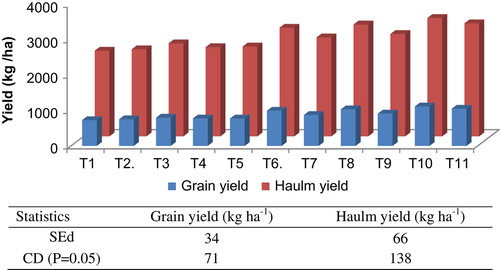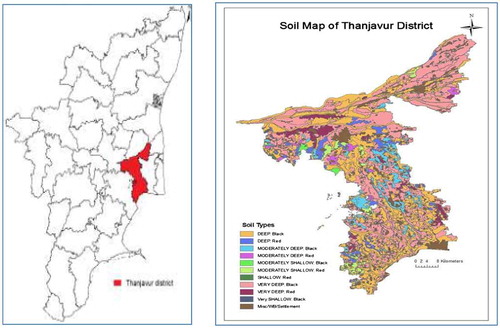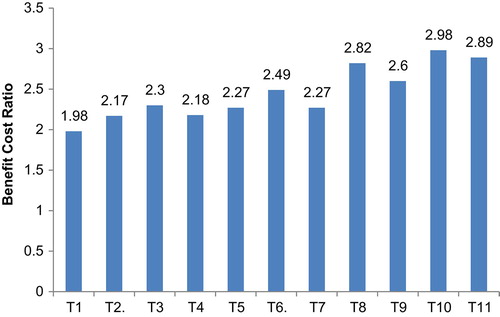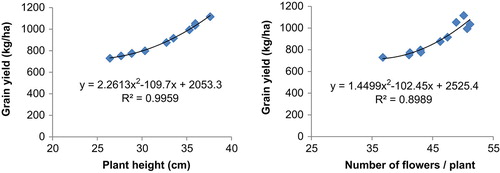 ?Mathematical formulae have been encoded as MathML and are displayed in this HTML version using MathJax in order to improve their display. Uncheck the box to turn MathJax off. This feature requires Javascript. Click on a formula to zoom.
?Mathematical formulae have been encoded as MathML and are displayed in this HTML version using MathJax in order to improve their display. Uncheck the box to turn MathJax off. This feature requires Javascript. Click on a formula to zoom.Abstract
Pulse productivity is very low in some of the sandy soil areas where, soils are having poor water and nutrient holding capacity. To improve the pulse productivity, field experiments were conducted at Agricultural Research Station, Tamil Nadu for two consecutive years to study the effect of phosphorus sources (mono- and diammonium phosphate) with brassinolide and salicylic acid on growth and yield of black gram in sandy loam soils. The experiment was carried out in a randomized block design with three replications during kharif season. The treatments include 100% recommended dose of NPK along with foliar application of monoammonium phosphate (MAP), diammonium phosphate (DAP), brassinolide (0.25 ppm), and salicylic acid (100 ppm) along with the combination of these treatments. TNAU pulse wonder at 5.0 kg ha−1 and TNAU micronutrient mixture (MN) at 5 kg ha−1 were also tried. The results revealed that application of 100% recommended dose of NPK + DAP 2% + TNAU pulse wonder 5.0 kg ha−1 was statistically significant and recorded higher plant growth (37.62 cm), number of pods / plant (37.15), yield of black gram (1162 kg ha−1), and benefit cost ratio (2.98) over the other treatments. The lowest black gram yield (730 kg ha−1) was recorded for control.
Public Interest Statement
Some of the soils are having poor water and nutrient holding capacity which leads to decrease in the available nutrient to crops and ultimately result in lower productivity and less profitability to the farmers. Foliar application of water soluble fertilizer nutrient may be the best option to maximize the productivity of any crops in such soils. Under such situation, a field experiment was conducted to assess the impact of nutrients and plant growth regulators on growth and yield of black gram in sandy loam soils of Cauvery new delta zone, India. The results revealed that yield of these pulses can be improved by doing such practice and farmers may be able to reap maximum profitability by adopting this practice. In other words for investment of one additional US dollar the returns will be three US Dollars. By visualizing the impacts, now many of the farmers in the nearby area started adopting this technology for improving the production.
1. Introduction
Black gram (Vigna mungo) is a widely grown grain legume and belongs to the family fabaceae and assumes considerable importance from the point of food and nutritional security in the world. Black gram is favorable short duration pulse crop as it thrives better in all seasons either as sole or as intercrop or fallow crop. India is the world’s largest producer as well as consumer of black gram. It produces about 1.5–1.9 million tons of black gram annually from about 3.5 million hectares of area, with an average productivity of 600 kg ha−1. Black gram output accounts for about 10% of India’s total pulse production (MoA, Citation2012). Productivity of black gram is low in general due to poor management and low soil fertility. The average productivity of pulses in Tamil Nadu is about (432 kg ha−1) which is very low when compared to Indian average of 610 kg ha−1.
The sluggish growth pulse production in the country could be due to various physiological, biochemical, and inherent factors associated with the crop (Mahala, Dadheech, & Kulhari, Citation2001). Black gram is basically indeterminate in habit of flowering and fruiting and there is a continuous competition for available assimilates between vegetative and reproductive sinks throughout the growth period. Since, the source is highly limited in pulses with lowered translocation of assimilates to the growing reproductive sinks. Apart from the genetic make-up, the physiological factors viz., insufficient partitioning of assimilates, poor pod setting due to flower abscission and lack of nutrients during critical stages of crop growth play a vital role on pulse production (Kalita, Dey, Chandra, & Upadhyay, Citation1994).
Growth regulating substances/growth regulators are known to influence a wide array of physiological parameters like alteration of plant architecture, assimilate partitioning, promotion of photosynthesis, uptake of nutrients (mineral ions), enhancing nitrogen metabolism, promotion of flowering, uniform pod formation, increased mobilization of assimilates to defined sinks, improved seed quality, induction of synchrony in flowering, and delayed senescence of leaves (Sharma, Sardana, & Sukhvinder Singh, Citation2013). These growth regulators, when applied as foliar spray at proper crop growth stage in optimum concentration could play a significant role in increasing crop yield and quality of produce in different field crops (Nagasubramaniam, Pathmanabhan, & Mallika, Citation2007). These plant growth regulators have been considered as software for plant development and improvement in crop productivity (Malik, Citation1995).
Salicylic acid (2-hydroxybenzoic acid), as a natural plant hormone, has many effects on physiological processes and growth of plants (Khan, Syeed, Masood, Nazar, & Iqbal, Citation2010). Furthermore, salicylic acid has an important role in tolerance of some environmental stresses such as heat, salts, and drought stress (El-Tayeb, Citation2005). Maity and Bera (Citation2009) revealed that foliar application of salicylic acid influences different physiological and biochemical aspects of green gram plant via increasing assimilation rate which revealed increasing in chlorophyll content and Hill reaction activity in the leaf. Brassinolide, a steroidal hormone of plant origin obtained from pollen grains of Brassica napus L. and salicylic acid commonly known as “Aspirin” obtained from bark of willow tree (Salix sp.) are now considered as new plant growth regulators and extensively used in agriculture for increasing crop yield. TNAU pulse wonder is the combination of nutrients and growth regulators which is exclusively developed in the laboratory of Crop Physiology of Tamil Nadu Agricultural University. Although importance of macronutrient in plant metabolism is well known, yet the role played by these growth regulators (brassinolide and salicylic acid) in plants and their impact on yield and quality components of pulses are not well understood.
Besides, the predominant soil type is sandy loamy texture in New Cauvery Delta Zone of Thanjavur. The soil is having poor water and nutrient holding capacity which leads to decrease in the available nutrient to crops. Hence, foliar application of water soluble fertilizer nutrient may be the best option to maximize the pulse productivity in this zone. In these lines much research findings are not available. Hence, the experiments were conducted to develop suitable nutrient management technology involving nitrogen, phosphorus, potassium, and micronutrients besides growth regulators to enhance the productivity of black gram.
2. Material and methods
2.1. Study area
The study area of Pattukottai is located in the New Cauvery Delta Zone of Thanjavur District, Tamil Nadu in the southern part of India (Figure ) and site characteristics are presented in Table (a). The soils of the experimental fields were analyzed for their physicochemical properties using standard analytical procedures and are also presented in Table (b). The soil of experimental site was sandy loam with a pH of 7.25, EC: 0.19 dSm−1, low in available nitrogen (81.2 kg ha−1), medium in available phosphorus (11.00 kg ha−1) and potassium (77.5 kg ha−1).
Table 1. Characteristics of the study area
2.2. Treatment details and crop management
Field experiments were carried out at Agricultural Research Station, Pattukkottai, Thanjavur during kharif 2010 and 2011. The experiment was carried out in randomized block design with eleven treatments and three replications. The treatments include 100% recommended dose of NPK without foliar application as control as T1; 100% of recommended dose of NPK with monoammonium phosphate (MAP- 0.5%) as T2; 100% of recommended dose of NPK with diammonium phosphate (DAP—2%) as T3; 100% of recommended dose of NPK with brassinolide (0.25 ppm) as T4; 100% of recommended dose of NPK with salicylic acid (100 ppm) as T5; 100% of recommended dose of NPK with MAP—0.5% and brassinolide (0.25 ppm) as T6; 100% of recommended dose of NPK with MAP—0.5% and salicylic acid (100 ppm) as T7; 100% of recommended dose of NPK with DAP—2.0% and brassinolide (0.25 ppm) as T8; 100% of recommended dose of NPK with DAP—2.0% and salicylic acid (100 ppm) as T9; 100% of recommended dose of NPK with DAP—2.0% and TNAU pulse wonder at 5.0 kg ha−1 as T10; and 100% of recommended dose of NPK with DAP—2.0% and TNAU micronutrient mixture at 5.0 kg ha−1as T11. TNAU pulse wonder is combination of nutrients and growth regulators used as crop booster for yield improvement. Similarly, TNAU micronutrient mixture is a combination of Zn, Cu, B, Mo, and Fe in different proportions for different crops, and in this experiment pulses TNAU micronutrient mixture was used.
Black gram seeds var. ADT 5 were sown in well manure field with a spacing of 30 × 10 cm and a plot size of 8 × 5 m. The 100% recommended dose of fertilizer (25:50:25 kg NPK ha−1) was applied to the entire plot before sowing. Mono- and diammonium phosphate and combination with brassinolide (0.25 ppm), salicylic acid (100 ppm) were sprayed at 30 and 45 days after sowing and TNAU pulse wonder at 5.0 kg ha−1 were sprayed on 45 DAS and enriched TNAU micronutrient mixture at 5 kg ha−1 was applied as basal. Observations on growth and yield parameters viz., plant height, numbers of flowers plant−1, number of pods plant−1, and 100 grain weight were recorded at maturity stage using the standard procedures. All other agronomic and crop management aspects were followed as per the recommendations of Tamil Nadu Agricultural University. Economics of foliar application of mono- and diammonium phosphate with brassinolide and salicylic acid were worked out by using the current market price of inputs and black gram grain. The net return per hectare was worked out for all the treatments by subtracting the cost of cultivation from the gross return. B:C ratio was also calculated as follows:(1)
(1)
2.3. Statistical analysis
Statistical analyses of the data were carried out according to randomized block design. The experimental data were pooled and the mean data for two years are subjected to statistical analysis as per methods suggested by Gomez and Gomez (Citation1984). All the parameters were subjected to analysis of variance (ANOVA) and the data were analyzed using AGRES statistical software by Tamil Nadu Agricultural University. Fisher’s Least Significant Difference was used to test the significant differences between the means, at probability level p ≤ 0.05 using the ANOVA. The non-significant treatment differences were denoted as NS.
3. Results and discussion
3.1. Growth and yield characters
Application of different sources of phosphorus, growth regulators, and micronutrient had positively influenced the growth, yield and economics of black gram (Table ). Application of 100% recommended dose of NPK + DAP 2% + TNAU pulse wonder 5.0 kg ha−1 (T10), had significantly recorded higher plant height (37.62 cm), number of pods per plant (37.15), number of flowers per plant (50.12), and fruit setting percent (72.55%) which was on par with 100% recommended dose of NPK + DAP 2% + TNAU MN mixture 5 kg ha−1 (T11). However, the application of 100% recommended dose of NPK + DAP 2% + Brassinolide 0.25 ppm (T8) registered the next best treatment on higher plant height, pods per plant, number of flowers per plant, and fruit setting percent; and this was on par with MAP 0.5% + Brassinolide 0.25 ppm (T6).
Table 2. Effect of mono- and diammonium phosphate with growth regulators and micronutrient on growth parameters of black gram (mean data of two years)
The significant increase in growth characters of black gram might be due to combination of nutrient and growth regulator foliar spray which play a major role in growth development and metabolism of black gram. The combination of DAP, Brassinolide combined with micronutrient might have favored better translocation of assimilates to sink resulted in improvement in growth and yield parameters. Foliar application of BR and SA might have enhanced the CO2 fixation, induced activity of carbohydrate synthesizing enzymes coupled with effective partitioning of dry matters into reproductive sink as reported earlier (Bera, Maity, & Maumdar, Citation2008). The reason for more number of pods per plant, number of seeds per pods might be due to the balanced metabolism maintained continuously inside the plant to subsequent phases of growth.
3.2. Grain yield
Effects of growth regulators on grain yield and haulm yield of black gram were significantly improved by the application of nutrients and plant growth regulators (Figure ). Grain and haulm yield (1116 and 3351 kg ha−1, respectively) was recorded higher in application of 100% recommended dose of NPK + DAP 2% + TNAU pulse wonder 5.0 kg ha−1 (T10) which was on par with 100% recommended dose of NPK + DAP 2% + TNAU MN mixture 5 kg ha−1 (T11). This might be due to beneficial effect of nutrients in combination with growth regulators applied at proper time and stage, which resulted in higher yield as reported by Kumaran and Subramanian (Citation2001). With respect to the application of TNAU pulse wonder, the possible reason for improvement in yield might be due to the nature of this crop booster with a combination of nutrients and growth regulators for pulses resulted in decreased flower shedding and improvement in the crop tolerance for abiotic and biotic stress.
Figure 2. Influence of foliar spray of macro-, micronutrient and growth regulators on grain and haulm yield of black gram (mean data of two years)

The foliar spraying of these might have exploited favorably for indeterminate crop for prolonged and continuous translocation of photosynthate. Apart from this, delayed senescence may also be attributed for the increase in yield. The production of higher seed yield due to growth regulators may be attributed to the fact that plants treated with growth regulators remained physiologically more active to build up sufficient food reserves for developing flowers and seeds. Similar kind of results on the foliar application of super phosphate and diammonium phosphate was found beneficial than soil application (Chandrasekar & Bangarusamy, Citation2003; Senthilkumar, Muthukrishnan, Ramasamy, & Chandragiri, Citation2008). Earlier studies, in the case of green gram also, foliar application of brassinolide and salicylic acid could be beneficial for improving yield and nutritional quality of green gram (Bera et al., Citation2008). Application of salicylic acid at 100 ppm increased number of pods plant−1, number of seeds pod−1, seed weigh plant−1, and seed yield ha−1 (Sujatha, Citation2001). Jeyakumar et al. (Citation2008) also reported that application of 125 ppm salicylic acid to black gram plants increased seed yield. The lowest black gram grain yield 730 kg ha−1 and haulm yield 2423 kg ha−1 was recorded in 100% recommended dose of NPK.
3.3. Economics
Application of 100% recommended dose of NPK + DAP 2% + TNAU pulse wonder at 5 kg ha−1 (T10) recorded higher benefit: cost ratio of 2.98 followed by application of 100% recommended dose of NPK + DAP 2% + TNAU MN mixture 5 kg ha−1 (T11) (Figure ). However, the next best treatment application of 100% recommended dose of NPK + DAP 2% + Brassinolide 0.25 ppm (T8) recorded benefit: cost ratio of 2.82 which was close to spraying of MAP 0.5% + Brassinolide 0.25 ppm (T6). Some of the earlier study also reported that foliar spray of DAP, NAA and micronutrients significantly improved seed yield of green gram and highest benefit cost ratio (Pradeep Mohan Dixit & Elamathi, Citation2007).The lowest benefit: cost ratio of 1.98 was recorded in 100% recommended dose of NPK.
3.4. Regression analysis
Quadratic response regression analysis on the grain yield of black gram was predicted for the impact of plant height (cm), number of flowers per plant, number of pods per plant, and fruit setting percent and the results indicated that the increase in these parameters has significantly improved the grain yield of black gram, which is reflected in the graph with the R 2 value and polynomial equation (Figures and ). For instance polynomial equation y = 2.261x 2 − 109.7x + 2053, with the R 2 value of 0.995 was observed for plant height with grain yield. Similar trend was observed with other parameters (equations depicted with Figures and ). The final yield of crop is the cumulative effects of growth attributes and such of those treatments which manipulate the favorable parameters could result in the positive relationship with higher productivity and this has been proved in the current study.
4. Conclusions
The present investigation concluded that application of 100% recommended dose of NPK + DAP 2% + TNAU pulse wonder at 5.0 kg ha−1 on 45 days after sowing can be recommended to exploit the genetic potential and increases the productivity of black gram as a nutrient management strategy to get higher productivity and profitability of black gram in Cauvery Delta Zone of Tamil Nadu, India.
Cover image
Source: Authors.
Additional information
Funding
Notes on contributors
S. Marimuthu
S. Marimuthu is as an assistant professor (Agronomy), Krishi Vigyan Kendra (ICAR), in Tamil Nadu Agricultural University, Vamban, Tamil Nadu, India. He is currently working on research projects such as studies on cotton-based cropping system with NPK levels and bioinoculants; effect of mono- and di-ammonium phosphate with growth regulators and yield of blackgram in sandy loam soils of Cauvery New Delta Zone and INM for yield maximization; economics of blackgram and soil health in Cauvery New Delta Zone as to name a few. Besides, he is also working on TN-IAMWARM project of Development and Adoption of rice transplanter for system of rice intensification and NADP (RKVY) Scheme on Enhancing rice production in salt-affected soils of Tamil Nadu. Apart from this, he is associated in teaching, training and other related activities of the university and also trains the state government department of agriculture staff and also the farmers on improved crop production technologies.
References
- Bera, A. K. , Maity, U. , & Maumdar, D. (2008). Effect of foliar application of brassinilide and salicylic acid on NPK content in leaf and nutritive values of seed in greengram. Legume Research , 31 , 169–173.
- Chandrasekar, C. N. , & Bangarusamy, U. (2003). Maximizing the yield of mungbean by foliar application of growth regulating chemicals and nutrients. Madras Agricultural Journal , 90 , 142–145.
- Day, P. R. (1965). Particle fractionation and particle-size analysis. In C. A. Black (Ed.), Methods of soil analysis, Part 1: Physical and mineralogical properties (pp. 549–567). Madison, WI: SSSA and ASA.
- El-Tayeb, M. A. (2005). Response of barley grains to the interactive effect of salinity and salicylic acid. Plant Growth Regulation , 45 , 215–224.10.1007/s10725-005-4928-1
- Gomez, K. A. , & Gomez, A. A. (1984). Statistical procedures for agricultural research (p. 680). New York, NY: Wiley.
- Jeyakumar, P. , Velu, G. , Rajendran, C. , Amutha, R. , Savery, M. A. J. R. , & Chidambaram, S. (2008). Varied responses of blackgram (Vigna munga) to certain foliar applied chemicals and plant growth regulators. Legume Research - An International Journal , 31 , 105–109.
- Kalita, P. , Dey, S. C. , Chandra, K. , & Upadhyay, L. P. (1994). Effect foliar application of nitrogen on morpho-physiological traits of pea (Pisum sativum). Indian Journal of Agricultural Science , 64 , 850–852.
- Khan, N. A. , Syeed, S. , Masood, A. , Nazar, R. , & Iqbal, N. (2010). Application of salicylic acid increases contents of nutrients and antioxidative metabolism in mungbean and alleviates adverse effects of salinity stress. International Journal of Plant Biology , 1 , 15–18.
- Kumaran, S. , & Subramanian, M. (2001). Effect of plant population and methods of nutrient application on yield and economics of blackgram. Research on Crops , 2 , 320–322.
- Mahala, C. P. S. , Dadheech, R. C. , & Kulhari, R. K. (2001). Effect of plant growth regulators on growth and yield of blackgram (Vigna mungo) at varying levels of phosphorus. Crop Research , 18 , 163–165.
- Maity, U. , & Bera, A. K. (2009). Effect of exogenous application of brassinolide and salicylic acid on certain physiological and biochemical aspects of green gram (Vigna radiate L. Wilczek). Indian Journal of Agricultural Research , 43 , 194–199.
- Malik, C. P. (1995). Plant growth regulators; software for plant development and crop productivity (pp. 1–5). Presidential address (Botany section) Indian Science Congress Association.
- MoA . (2012). Agricultural statistics at a glance . Ministry of Agriculture, Government of India.
- Nagasubramaniam, A. , Pathmanabhan, G. , & Mallika, V. (2007). Studies on improving production potential of baby corn with foliar spray of plant growth regulators. Annual Review of Plant Physiology , 21 , 154–157.
- Olsen, S. R. , Cole, C. V. , Watanable, P. S. , & Bean, L. (1954). Estimation of available phosphorus of soil extraction with sodium carbonate (Circular No 939). Washington, DC: US Department Agriculture.
- Pradeep Mohan Dixit, S. , & Elamathi, S. (2007). Effect of foliar application of DAP and micronutrients and NAA in mungbean. Legumes Research , 30 , 305–307.
- Senthilkumar, G. , Muthukrishnan, P. , Ramasamy, S. , & Chandragiri, K. K. (2008). Effect of organic and inorganic foliar spray on growth and yield of balckgram. Madras Agricultural Journal , 95 , 57–60.
- Sharma, P. , Sardana, V. , & Sukhvinder Singh, K. (2013). Dry matter partitioning and source–sink relationship as influenced by foliar sprays in groundnut. The Bioscan , 8 , 1171–1176.
- Stanford, G. , & English, L. (1949). Use of flame photometer in rapid soil test for K and Ca. Agronomy Journal , 41 , 446–447.
- Subbiah, B. V. , & Agija, G. L. (1956). A rapid procedure for estimation of available nitrogen in soils. Current Science , 25 , 259–260.
- Sujatha, K. B. (2001). Effect of foliar spray of chemicals and bioregulators on growth and yield of greengram (Vigna radiata L.). (MSc thesis). Tamil Nadu Agricultural University, Coimbatore.




